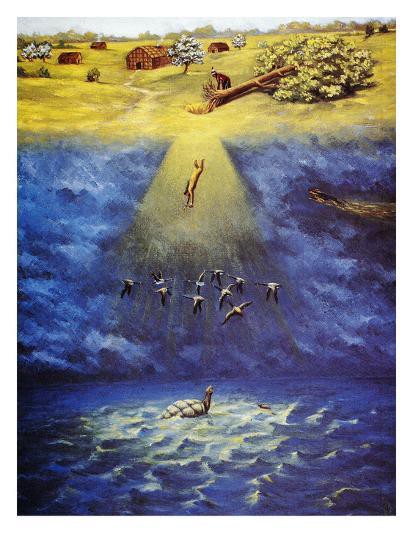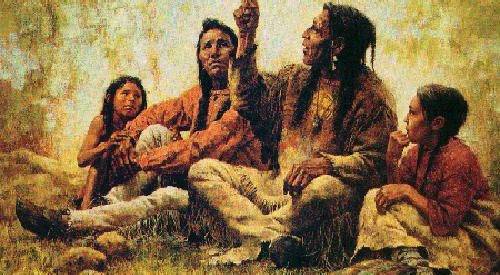The Iroquois, Yakama, and Cherokee
Each Native American tribe has its own story of its origin. While scientists believe Native Americans originated in Asia and came to the Americas via a land bridge between modern day Russia and Alaska, a second theory posits that ancient Asians came to the Americas by boat, traversing the Pacific coast. Regardless, these two theories are rooted in scientific discovery, while Native American origin stories are rooted in legend. Passed down orally from generation to generation. Although from different corners of the continent, Iroquois, Yakama and Cherokee tribal origin stories are in fact, similar.
 Iroquois Creation Myth
Iroquois Creation Myth
Iroquois legend tells of a great island floating in the sky on which the Sky People lived long before the world existed. Feelings of death and sadness were not experienced amongst the Sky People. However, one day the Sky Woman realized she was giving birth to twins and her husband flew into a rage. Her husband tore out a light-giving tree and as she peered through the hole, her husband pushed her down, to the world below. Two birds caught her and carried her to other animals. These other animals created the land by bring mud from below the sea. The Sky Woman stepped onto that land and created the moon, sun and stars. She gave birth to twin sons, Sapling and Flint. Sapling was the good son and Flint, the evil one. Sapling created all that is good in the world while Flint worked to destroy it. In the eventual battle between good and evil, Sapling emerged victorious, but did not kill Flint. The Iroquois have a great respect for all animals that is displayed throughout their origin story, for if not for the animals? help, Sky Woman would have drowned and never created the earth.
 Yakama Warrior
Yakama Warrior
The story of the origin of the Yakama tribe tells of the Great Chief Above who lived all alone. When he made the world, he went down to shallow places in the water and created land out of mud. He piled some of this mud so high it froze and became the mountains. The Great Chief Above also created the trees, roots and berries. He made man out of a ball of mud and instructed him to take fish from the water and deer from the forests. He then created woman to combat the man?s loneliness taught her about berries, roots and basket making and how to cook and dress skins. She handed these skills down to their daughters and granddaughters. Despite all the gifts from the Great Chief Above, the people quarreled. They quarreled so much that Mother Earth shook the mountains so hard that she created rapids and waterfalls. The falling rocks killed some people and animals.

The Cherokee people believe, that in the beginning, all animals were above in Galunlati, beyond the arch. It was very crowded, and the animals needed more space to wander, so they dispatched a water-beetle who went to the water filled earth to see if anything could be found. He darted all across the earth but could find nowhere to rest so he dove to the bottom and brought up mud. This mud grew and spread until it became what we now know as Earth. The mud was still very wet, but the animals were getting anxious so they sent out the Great Buzzard, when he reached Cherokee country, he was exhausted, and his wings flapped and struck the ground, and wherever they struck the earth there was a valley, and where they turned up again there was a mountain. Cherokee country remains full of mountains to this day. The animals finally came down when the earth was dry and they created the Sun and everything else in the world.
These creation stories of three tribes from across North America reference a great power in the sky from which their people descend. Each of these legends of creation are true oral traditions passed down from generation to generation. Protected not by pen and paper, but rather by word of mouth, only recently written for posterity. Despite terrible actions taken against them by settlers and the U.S. government, the ability of these tribes, like many others, to preserve their oral traditions is a testament to their ability to persevere.


